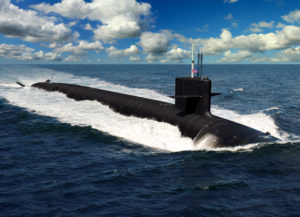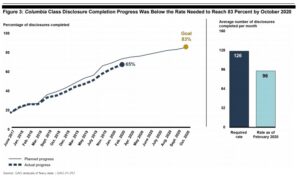The Government Accountability Office (GAO) released a new report on Jan. 14 warning issues with a new digital design tool and further effects threatens the cost and schedule of the Columbia-class ballistic missile submarine (SSBN).
The report, “Delivery Hinges on Timely and Quality Materials from an Atrophied Supplier Base,” said the Navy’s schedule for the lead SSBN is threatened by continuing challenges with the computer-aided software tool prime contractor General Dynamics Electric Boat [GD] is using to design the vessel.
This is a public release of a previous sensitive document originally issued last November, with the performance audit covering May 2019 to November 2020.

Starting with the Columbia-class, Electric Boat moved to a new “customized software tool for design and construction” because the previous tool was no longer supported by the original developer.
However, it reported “Electric Boat faces persistent problems with its design tool leading to cost increases and schedule delays during the design phase. Late completion of design products threatens to impede construction progress and indicates challenges in the Columbia class program’s ability to achieve the lead submarine’s construction schedule.”
GAO underscored Electric Boat generally has not met planned design schedule for the lead vessel largely due “persistent inefficiencies associated with its new software-based design tool.”
This new tool integrates new capabilities, like enhancements to material ordering and cable routing, and was originally expected to reduce the average hours needed to finish design disclosures by almost half the time required for the Virginia-class attack submarine program.
Both the shipbuilder and the Navy program office expected these capabilities to enable greater efficiencies than previously possible.
The tool’s software problems kept the company from realizing expected efficiencies and “consequently, Electric Boat is behind schedule in producing key design products—design disclosures and work instructions—and as a result is experiencing delays in ordering materials needed to support the construction schedule.”
GAO argued these delays in turn led to cost increases, because the shipbuilders required additional work hours to complete the design products.
The Navy frequently notes the first ship must be finished on time to conduct its first nuclear deterrent patrol in early fiscal year 2031, when the Ohio-class SSBNs start retiring. Moreover, there is little schedule margin left in the program after other early delays, notably welding issues with missile tubes for the Columbia-class, trimmed some of the margin.
In 2019, GAO reported Electric Boat was not competing design disclosures at the rate needed to reach the planned 83 percent by the beginning of lead submarine construction in October 2020. These design disclosures establish the dimensions and components of materials needed.
“We also reported that the program needs to complete 83 percent of its design disclosures to achieve the savings assumed in its estimate of program cost. Electric Boat remains behind schedule on completing design disclosures and will have to improve performance in the coming months to meet the program’s goal,” GAO said.
According to Electric Boat data, GAO said the company missed its monthly disclosure completion goals in all except one month in 2019 and the company was not on track to meet its disclosure completion goal without increasing the amount of disclosures by at least 32 percent.
While GAO collected data through November 2020, it only presented disclosure completion through early 2020.
The report said delays in design disclosures “have led to cascading effects for other design products and activities that must be completed to maintain the construction schedule for the lead submarine.”
These delays specifically hampered the shipbuilders’ progress in developing work instructions and ordering materials.
Navy program officials told GAO before original publication that they expected the rate of disclosures to increase in 2020 and the company added 313 more designers than originally planned to the disclosure completion effort and was adding more staff than originally planned to develop work instructions. The report noted this increased the cost to the government per disclosure.

Moreover, Electric Boat is trying to accelerate material orders by developing data before the associated disclosures are written, “a process that requires effort from the same design staff tasked with completing disclosures and which will increase their workload. Mitigating delays caused by the design tool with additional staff will likely allow the shipbuilder to complete design products more quickly, but it will also increase the cost of design.”
GAO warned the effects of earlier disclosure delays presents a risk to achieving the lead vessel’s delivery date.
“For example, by January 2020, Electric Boat planned to have completed 6 percent of the work to build the lead submarine during advance construction, but only completed half that amount. Delays to design products and material orders are contributing factors in these construction delays. The program’s plan to complete the construction of the lead submarine within 84 months depends on successful advance construction efforts to reduce the amount of work during formal construction to an achievable level.”
GAO said late work instructions have already impeded construction progress, notably with work instructions for the missile deck module of the common missile compartment not finished on time. To reduce the risk to the delivery schedule, program officials accelerated work on the submarine’s six super modules so they have no more than three months of schedule margin in their completion dates.
“These trends indicate that construction delays have the potential to rapidly grow if the underlying problems are unresolved before the program increases its construction pace following formal authorization for construction of the lead submarine,” GAO said.
In November, Navy officials said they are trying to extend the life of some Ohio-class SSBNs past the already-extended 42 years to provide more schedule margin to the Columbia-class (Defense Daily, Nov. 19, 2020).
Also that month, Columbia-class Program Manager Capt. Jon Rucker said the Navy and Electric Boat agreed to an 84-month build sequence threshold for the first vessel but are trying to shorten it to 78 months to add margin (Defense Daily, Nov. 6, 2020).
Separately, the report said Congress has not been given with the most likely cost of construction before deciding to provide authority to build the first two vessels, which it provided earlier this year.
“Program officials, however, told us that the Navy’s $14.4 billion budget submission for the cost to construct the lead submarine underestimates the most likely costs in order to preserve a competitive negotiating position with Electric Boat for Build I.”
GAO said the SSBN program will now likely need additional funding later due to these kind of delays.
To this end, the report said the budget request did not include an independent cost estimate from the Office of the Secretary of Defense’s office of Cost Assessment and Program Evaluation (CAPE), which was finished in August 2020.
GAO said the program’s previous cost estimate used to inform the budget request “reflects an assumption that it will achieve cost savings by completing 83 percent of disclosures by the start of lead submarine construction. The program estimated that doing so would avoid the cost growth experienced by other recent shipbuilding programs by avoiding re-work resulting from design changes after construction had started. However, as discussed above, the program is not on track to meet that goal and, as a result, it is unlikely to realize the cost savings it planned.”
The report said the cost assumption is also wrong because the program expanded how much advance construction work is finishing before the schedule disclosure goal, “effectively resulting in more construction work being done with fewer design disclosures completed than assumed.”
The Defense Department’s comments to the report are included in the publication, with several parts redacted. DoD said the program achieved its OSD assigned exit criteria of 83 percent design maturity in May 2020.
‘The Senior Technical Authority and the Chief Systems Engineer for Submarines validated that the Critical Design Review has been completed, and certified that all areas of the shipbuilder’s ship design were mature and supported development of production information, that the ship design was stable, and that a configuration control baseline has been maintained,” DoD said.
“The Navy notes that this unprecedented level of readiness for construction is in spite of the fact that there have been problems with the development and implementation of the next generation design tool,” it continued.
GAO responded to the DoD comments that they agree a high level of design maturity is essential in preventing cost and schedule delays that impact other shipbuilding programs.
“However, as we explain in the report, the program does not expect to achieve its specific goal for the completion of design disclosures by the start of construction that was established in 2016 as a prerequisite for achieving overarching cost goals. As a result, program officials told us that the program will not achieve the cost savings that they initially projected if they had reached their original design disclosure completion goal.”